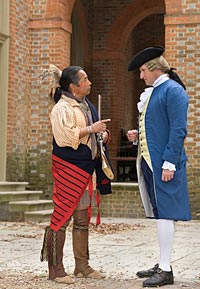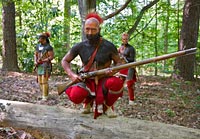Page content
Captain Tom Step
- Nottoway Indian
- Multi-lingual in European and Native languages
- Literate
- Fought for Virginia during the French & Indian War
Childhood
Born in Isle of Wight County c.1725, Tom Step was raised in an Iroquoian-speaking community on the colonial frontier. During the first half of the 18th century, the Nottoway Indians had two towns south of the Blackwater River, the larger one situated along Assamoosick Swamp in present-day Southampton County, Virginia.
During Step’s youth, the Nottoway Great Town was fortified and served as a trading center for Euro-Indian commerce and as a military rally point for colonial rangers. Land speculators, surveyors, Indian traders, and planters were some of the frequent colonial visitors to the Native villages.
Tom Step grew up during a period of change for Nottoway people: he learned to use the bow and arrow alongside firearms; his grandparent’s clothing of buckskin was replaced with that of manufactured cloth; the deer he hunted became more valuable for the skin trade than as a food source. The introduction of alcohol, domesticated animals, slave labor and ideas of property division drastically altered the cultural landscape surrounding Tom Step’s natal community.
The Brafferton Indian School at the College of William & Mary
The Nottoway were tributary to the English Crown, via the Virginia governor, since the 1677 Treaty of Middle Plantation. Visits to Jamestown, and later Williamsburg, were commonplace. The Nottoway paid a quit rent of three arrows and a tribute of twenty beaver skins to the governor at his residence in March of each year.
By Tom Step’s time, the Nottoway annual tribute was suspended in favor of sending Nottoway youth to the Brafferton Indian School at the College of William & Mary. It is likely that Step attended the school founded for the “Western Indians” education in “good letters and manners, and... the Christian faith.” Later records indicate Step was literate and spoke two or three Indian languages, as well as English.
During the early 1750s Tom Step, “one of the chief men,” is referenced in several Nottoway deeds and the Journal of the House of Burgesses. His contemporary headmen were also students of the College and frequenters of Williamsburg. Iroquoians Alexander and Robert Scholar most likely took their surname from the title given to the colonial students of William & Mary, “Scholars.” Nottoway students, like Tom Step and the Scholars, continued to attend the Brafferton School until its closing in the 1770s.
Diplomat and War Captain
Native diplomacy and tribal emissaries in Williamsburg were constant during the eighteenth century. The Nottoway signed several treaties in the colonial capital and were present for dozens of exchanges between Virginia and the Northern Iroquoians, Cherokee, Catawba and their Siouan-speaking allies. In one instance, Tom Step and other Nottoway headmen lead a treaty delegation to confront Cherokee ambassadors in Williamsburg. The August 16th, 1751 edition of the Virginia Gazette recounts the Nottoway-Cherokee heated discourse, wampum presentation, and ceremonial pipe smoking on the steps of Williamsburg’s courthouse. The peace bonds that Step and other Nottoway made with the Cherokee encouraged their later united participation in the French & Indian War.
As allies to the British Crown, Tom Step led the Nottoway to Williamsburg “to renew their ancient League with their brothers the Cherokees, which was done in the Market Place, by smoking the Pipe, &c. after which the Cherokee Warrior made a long speech, desiring the Nottoways to go immediately to the Assistance of their Brothers the English.” In April of 1756, Step and fifteen other Nottoway joined the Cherokee warriors, following Isle of Wight’s Lt. James Baker to assist Lt. Colonel George Washington in Winchester.
During the War, Tom Step was referred to as “Captain Tom,” leading war parties against the French and their Indian allies in the disputed territory of western Pennsylvania and Maryland. The summer of 1756 was particularly difficult on the forward garrisons – supplies and dwindling recruitments left much to be desired.
Lt. Governor Robert Dinwiddie and Lt. Colonel Washington encouraged the Cherokee, Catawba, and Tuscarora to join Virginia and the Nottoway against the French; Washington believed their service was worth “more than twice their number of white men” in the woodland warfare of the frontier. In August, Washington sent Capt. Tom Step with wampum and a speech to formally invite the Tuscarora and other tributary Indians to join the Virginia ranks. Capt. Tom persevered, recruiting upwards of seventy Nottoway, Tuscarora, and Meherrin warriors.
Eventually joined by Catawba and more Cherokee, Step and the Nottoway fought “against the French, faithfully and honestly, until the reduction of Fort Du Quesne...and did behave themselves with great Bravery during the...campaign...” Near the conclusion of the hostilities, Washington and the House of Burgesses singled out “Tom Step, who distinguished himself very remarkably in the Action…” The House ordered “...that the Treasurer be desired to purchase a Silver Gorget and suit of Clothes, [to] be presented to Captain Thomas Step, one of the Nottoway Indians, as a mark of distinction, and as reward for his brave and gallant behavior during the last campaign.”
Later Years
Thomas Step continued to be a primary figure in Nottoway politics and commerce, appearing in the colonial capital with land sale petitions and arguing for Nottoway monetary compensation for wartime service. He possibly fought alongside Virginians and the Tuscarora in the Cherokee War of the early 1760s. Step’s leadership may have also influenced Tuscarora reservation land sales and leases in North Carolina. A number of Nottoway, Meherrin, and Tuscarora removed from Virginia – Carolina in the mid 1760s – the body taking residence in New York among their Iroquois brethren.
Doubtless, the connections made during the late northern war rekindled kinship ties with the Six Nations. A portion of the communities remained in Virginia, but became increasingly politically isolated and marginalized. Nottoway connections with Williamsburg declined after the Indian school closed in 1777 and the capital moved to Richmond in 1780. Capt. Tom’s descendants and relatives continued in Southampton County, where the Step surname survived among the Nottoway well into the 19th century.
Learn more:


